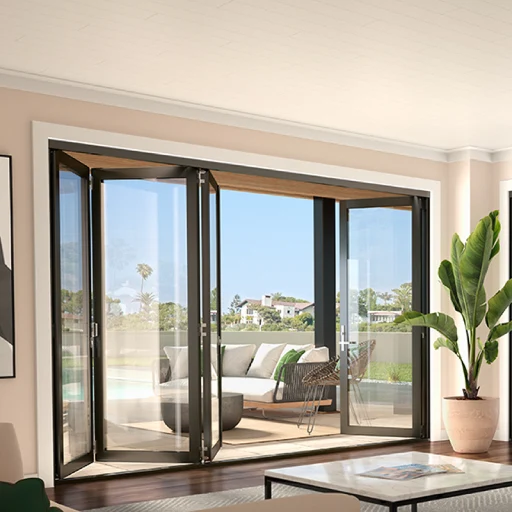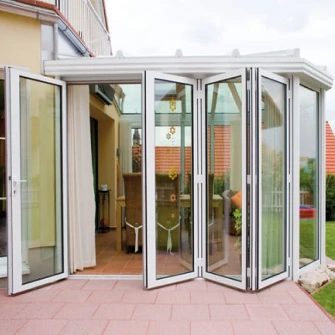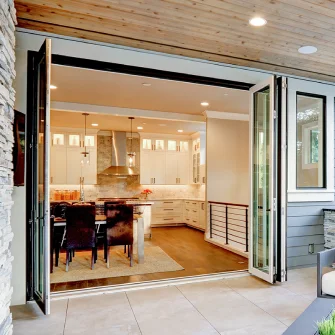Best choose
Where to Use Bi-Fold Glass Walls
A bi-fold glass wall is a door system composed of multiple hinged glass panels that fold against each other-much like the pages of a book-and neatly stack to one or both sides of the opening. Unlike traditional sliding doors that simply slide left or right, bi-fold walls can virtually remove an entire stretch of the exterior boundary, creating a vast open gateway to the outside. This approach is especially popular for homeowners who want a modern, spacious look and a more immersive indoor-outdoor living experience.

Expansive Openings
When fully retracted, the panels occupy minimal space at the edges of the frame, leaving a wide-open passage.
Hinged Panels
Each panel is connected by hinges, allowing them to fold and stack.
Versatile Sizes
Can accommodate large openings (spanning 20 feet or more) or smaller ones, depending on the number of panels.
The Pros of Bi-Fold Glass Walls?
- Expansive Openings
Folds nearly all panels away to create an exceptionally wide passage. - Modern Elegance
A sleek, up-to-date look that adds architectural value and curb appeal. - Increased Ventilation
Let in abundant fresh air, ideal for warm climates and cooling indoor spaces naturally. - Ample Natural Light
Large glass areas brighten interiors, reducing daytime lighting costs. - Easy Operation
High-quality folding systems glide smoothly, even with multiple panels. - Potential for High Security
With multi-point locks and tempered or laminated glass, these systems can provide robust protection.



Frequently Asked Questions (FAQ)
Are bi-fold glass walls secure enough for residential use?
Yes. Most modern bi-fold walls include tempered or laminated glass, multipoint locking systems, and strong frame materials. When installed and maintained properly, they provide robust security comparable to other high-quality door systems.
How do bi-fold doors compare to sliding glass doors in terms of cost?
Bi-fold doors are typically more expensive due to their complex hinging mechanisms, potential for multiple panels, and specialized hardware. However, the seamless look and wide openings can justify the investment for many homeowners.
Can I install a bi-fold glass wall if I have limited outdoor space?
It depends. Outward-folding panels require space on the patio or deck to stack, while inward-folding systems occupy indoor real estate. If space is limited on both sides, you may consider a smaller bi-fold system or other door styles like pocket walls.
Are bi-fold glass walls energy-efficient?
Yes-if you choose energy-efficient glass (Low-E coatings, double- or triple-pane) and well-insulated frames. Proper installation and sealing further minimize air leakage. Larger glass areas may still influence heating or cooling costs, so weigh that factor in your decision.
What’s the maximum width for a bi-fold glass wall?
Systems can span well over 20 feet or more, depending on the manufacturer, frame materials, and track support. The number of panels needed will correlate to the overall width.
Can I incorporate a screen to keep out bugs?
Absolutely. Many systems offer integrated screen panels-either retractable or slid on a parallel track-allowing you to enjoy fresh air without inviting insects indoors.
Do bi-fold glass walls function in cold or snowy climates?
Yes, provided they’re constructed with weatherproof seals, robust frames, and insulated glazing. Regularly clearing snow from thresholds and maintaining the tracks prevents ice buildup that could affect operation.
What if I only want to open one door occasionally?
Many bi-fold systems include a traffic door-the first panel acts like a standard swing door, enabling everyday entry or exit without folding all panels.
How long does it take to install bi-fold glass walls?
The timeline varies based on project complexity, the size of the opening, and structural modifications needed. A straightforward replacement in a prepared opening might be done in a day or two, while major remodeling can take longer.


